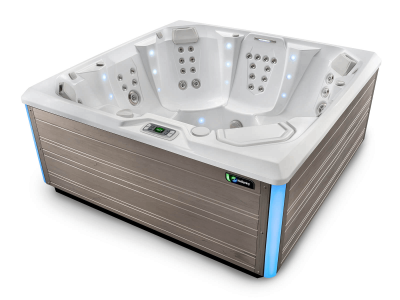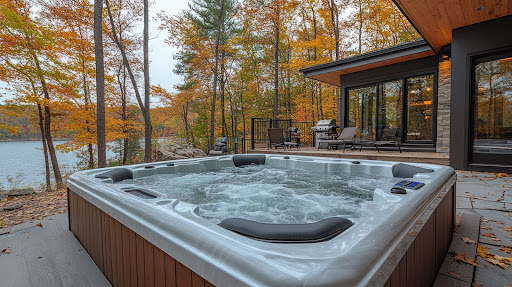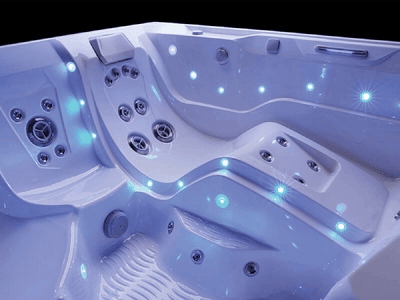Having a hot tub at home is one of the few pleasures most of us are lucky to enjoy. Hot tubs, also commercially known as jacuzzis, are very helpful for hydrotherapy and relaxation, making them crowd-pleasers.
However, what if you have one at home? How do you take care of it? You see, hot tubs need care and certain treatments to keep the water clean, odour-free and algae-free.
Today, we’ll help you learn all about hot tub chemicals, how to use them properly, and the signs that tell your hot tub needs care.
Importance of Hot Tub Chemicals

Adding chemicals to your hot tub isn’t just about making the water cleaner or looking better. Using chemical treatments impacts everything from safety and comfort to the long-term performance of your hot tub.
Here’s a quick outline of what chemicals can do for any hot tub owners:
1. Ensure Safe Water for Everyone
One of hot tub chemicals' most important roles is keeping the water free from hazardous bacteria, viruses, and algae that thrive in warm environments.
If you don’t regularly use hot tub cleaners, you’ll find it quickly turning into a breeding ground for contaminants that could cause skin irritations, infections, or even serious health issues.
Of course, this problem could be worsened by the hot tub’s environment, especially if it's placed outdoors. Being exposed to the elements means your hot tub is more likely to accumulate debris like leaves, dirt, and insects, which can contaminate the water.
2. Extend the Hot Tub’s Lifespan
Can you imagine what happens to your hot tub when algae accumulate or the pH balance isn’t correct?
The wrong pH balance or lack of essential chemicals can lead to corrosion in metal parts or cause mineral build-up, damaging the plumbing, heater, or other internal components.
Keeping a consistent treatment schedule can help you avoid these problems and hopefully elongate your hot tub’s longevity. In the long term, this can save you lots of effort and restoration money.
3. Improves Water Quality
Clear, sparkling water isn’t just for aesthetics; it’s a sign your hot tub is in tip-top shape! When your chemicals are balanced, they keep the water clear, fresh, and inviting.
Using low-quality chemicals or not adding any treatment can also contribute to this issue. In addition to clarity, properly treated water feels better on your skin and eyes, allowing you to enjoy the hot tub without your eyes stinging or skin irritation.
6 Must-have Hot Tub Chemicals

Before we dive too deep into the required hot tub supplies, we should let you know there are many more than the ones listed below.
There are other optional chemicals hot tub owners use, such as clarifiers and calcium hardness increasers. However, the ones below are some of the most popular and helpful when it comes to maintaining hot tubs.
1. Chlorine
Chlorine is perhaps the most widely recognized sanitizer for hot tubs, and pools thanks to its effectiveness in killing bacteria, viruses, and algae.
What makes chlorine the top choice for many pool and hot tub owners is its affordability and widespread availability. However, it comes with its downside.
If not properly balanced, it can lead to a strong, unpleasant odour and may cause skin or eye irritation. Also, it can degrade quickly under sunlight, meaning you’ll need to monitor and adjust the levels frequently if you have an outdoor tub.
2. Bromine
Another popular sanitizer that’s often used as an alternative to chlorine is bromine. It’s particularly well-suited for hot tubs because it remains effective in higher temperatures and has a lower odour when compared to chlorine.
One of its major advantages is that it maintains its effectiveness longer in the water requiring fewer adjustments. You can also find bromine tablets which you can use for daily use!
That said, bromine has its own set of drawbacks. It tends to be more expensive than chlorine, and some people find it can still cause irritations, especially if not properly balanced.
3. Biguanide
You’ll find that biguanide isn’t as famous as chlorine and bromine. However, it’s a great alternative for those sensitive to the two previous options.
Similar to bromine, it doesn’t break down in the sun, meaning it’s fantastic for outdoor hot tubs. However, biguanide does come with a few caveats!
It’s typically more expensive than chlorine and bromine and it isn’t compatible with other common chemicals, meaning you’ll need to commit fully to its system.
4. A Total Alkalinity Increaser
A total alkalinity increaser helps preserve the general balance of your water by stabilizing pH levels, ensuring that the water doesn’t become too acidic or too basic.
To illustrate, the pH levels fluctuate rapidly when your water's alkaline levels are too low. As a result, you’ll feel that the water is either too harsh or too soft for comfortable soaking.
And, of course, in such a scenario anything you add to the water, human or otherwise, could change its pH levels.
That’s why adding the total alkalinity increaser can help prevent these swings and keep your water chemistry stable.
5. pH Decreaser
So, what happens if you don’t have a total alkalinity increaser currently and your pH levels are all over the place? That’s where the pH increasers and decreasers come in handy.
An important piece of information every hot tub owner should know is that your optimal pH level ranges between 7.2 and 7.8. If the pH level rises too high, it can cause the water to become too basic, leading to several issues such as cloudy water, scale build-up, and skin irritation.
A pH decreaser, typically made of sodium bisulfate, helps lower the pH level and restore the balance.
6. pH Increaser
On the flip side, if your hot tub’s pH levels drop too low, the water becomes acidic, which can lead to corrosive conditions, possibly damaging the hot tubs.
A pH increaser, often made from sodium carbonate, raises the pH level to bring it back to the desired range.
Similar to high pH levels, low levels can also damage your hot tub’s metal components, such as the heater, costing you in future repairs. Regular testing is key to avoiding the possible issues associated with pH imbalance.
When Does Your Hot Tub Need Chemicals?

You should completely drain and flush your hot tub three to four times a year. We recommend timing it with the beginning of each season to make it easier to remember.
However, when it comes to sanitization, this should be weekly or when you see one of the following signs:
1. Murky Water
It's a clear sign something is off with the water chemistry when your hot tub water appears cloudy or murky.
If you’re unsure if this murky appearance is from the water movement or a chemical imbalance, stop the jets and let the water rest for a few moments.
If the water still looks unclear, there’s a chance you have a problem with the pH levels, total alkalinity, or the sanitizer. A problem with any of the three can lead to bacteria growth and organic matter in the water, leaving you with an unpleasant experience.
2. Algae
Algae growth is one of the clearest signs that your chemical levels aren’t properly maintained. Algae thrive in warm, untreated water. Also, once they begin growing, they can cling to the hot tub’s surface and even clog the filters, making them hard to remove!
Algae often form green, yellow, or black spots, making the hot tub look unappealing and certainly unsafe for use.
3. Odour
If you use sanitizers like chlorine and bromine in your hot tub, then you already know what their scent is supposed to be like.
So, if your hot tub develops a strong or unpleasant odour unlike the familiar one you know, it’s a clear sign that the water has become contaminated.
This can be caused by a build-up of bacteria, mould, and mildew, particularly in the plumbing lines or filter. Depending on the underlying issue, the smell can range from musty to chemical-like.
4. Skin Irritation
If you or others experience skin irritation after using the hot tub, this is a clear red flag that the water chemistry is off.
High levels of sanitizers, such as chlorine or bromine, can easily cause skin dryness or irritation if not balanced.
On the other hand, low sanitizer levels can allow bacteria and other contaminants to grow, leading to skin infections or rashes.
How to Add Chemicals to your Hot Tub

Adding chemicals to your hot tub isn’t as difficult as you may think it is. The process requires a few simple steps and a bit of attention to detail to guarantee the water remains balanced and safe.
Here’s a quick step-by-step guide to make the process easy and manageable:
- Check out your hot tub’s water capacity to learn the exact amount of chemicals you should use. We suggest googling the model or returning to the manufacturer’s manual.
- Use a hot tub water test strip to understand what you’ll need to add—it can tell you a lot about your tub’s pH levels and alkalinity.
- Wear gloves, a mask, and goggles for maximum protection.
- Measure the chemicals according to your tub’s capacity.
- Keep the jets running, close the air valves, and remove the cover.
- Add the chemicals one by one (don’t mix them before), and wait at least 20 minutes between each addition or until the previous chemical is entirely dissolved in the water.
Final Thoughts
In short, adding the right hot tub chemicals is essential for keeping your tub safe, clean, and enjoyable!
When you use key hot tub supplies like chlorine, bromine, or biguanide, you can sanitize the water, eliminating harmful bacteria and preventing algae growth.
Also, balancing pH and alkalinity ensures your water remains clear and protects your skin and the hot tub’s components from damage.
So, regularly test your water to learn what chemical adjustments are needed to prevent costly repairs and ensure a relaxing soak!

